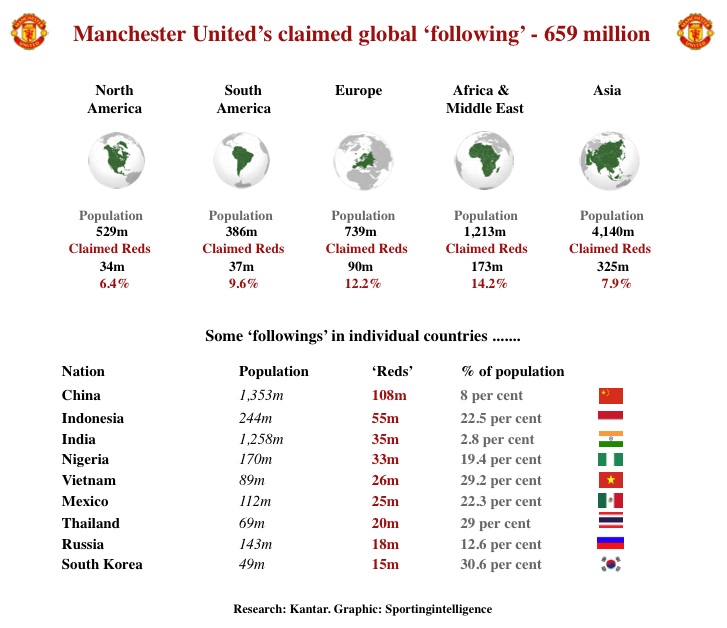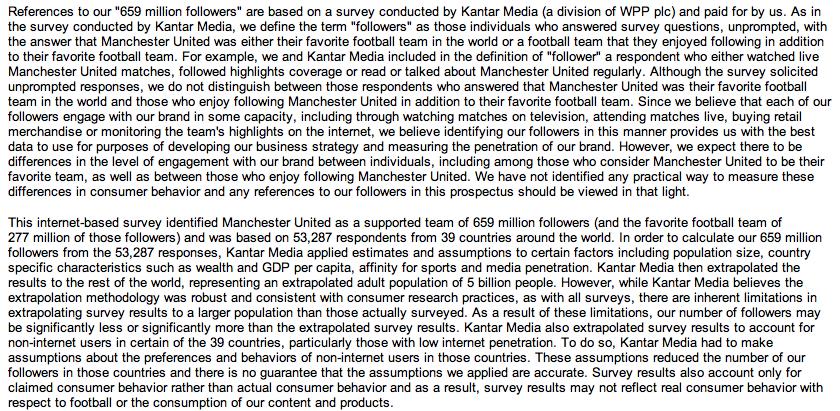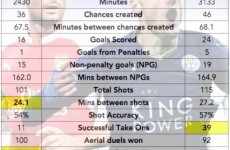By Nick Harris
SJA Internet Sports Writer of the Year
7 June 2012
WHEN Manchester United announced last week that they had 659 million followers and are thus “the most popular club in the most popular sport in the world”, the figures were met with widespread scepticism, even derision. But I can only speak for myself.
The headline figures and some background are in this United website article, which also features a video with quotes from United’s commercial director, Richard Arnold, and from Richard Brinkman of KantarSport – the firm who conducted the huge global survey.
My initial reaction was these findings are linked to a probably imminent second attempt at an IPO in Singapore. That remains my hunch.
Headlines saying one in 10 of the world’s entire population ‘support’ United can only be positive in such a scenario, even though United themselves carefully say ‘follow’.
I also felt that the numbers were pie in the sky, meaningless. We’ll come back to that; actually the numbers do mean something, just not what most people (in the UK at least) would understand as United having 659m ‘fans’.
Having spent some time digging into the methodology and exploring some of the fuller findings – the scant details of which I’ve been able to obtain – it seems clear:
- United are the most popular club in world sport, but I didn’t doubt that anyway.
- The group of 659m people are not ‘fans’ as we’d typically define a ‘fan’ in Britain, but they are a group exhibiting more than a simple recognition of United’s name.
- Quite probably, these 659m people are a group who might, in some circumstances, at some stage, be convinced to part with some money, for a product (including a TV subscription) that allowed them access to United in some way, shape or form, even if that money (for TV subscription / internet payment / phone subscription / consumer good) didn’t directly enter the coffers of United, but only a fraction of it got back to United. NB: late addition to piece. United later effectively confirmed this in their New York IPO documentation, where they also revealed 277m of the 659m followers cited United as their favourite team. Scroll to very bottom on this piece for screen grab of that.
- Barcelona and Read Madrid (and Liverpool and perhaps a very few others) are also massively popular, globally, and United know this, because Kantar collected data on them too.
- United don’t yet make much if any direct cash from the vast majority of these ‘followers’.
- But in a rapidly changing global marketplace with technology developing fasteer and in ways it’s hard to predict, a nebulous ‘following’ may yet bring monetary rewards. And as and when that happens, it will mean better players and higher wages at United (or more cash to repay the Glazers’ leveraged debt at least).
.
Those are the quick conclusions and if you’re bored already, look away now, as we explore the survey findings, what they mean, and a few anomalies in greater depth.
Another survey of United’s global support, published a mere five years, said United had 333 million followers, of which 139 million were ‘core fans’.
Of the 333 million, I was told that 27m of them were in South Korea.
On a trip last year to South Korea, I found that Park Ji Sung was a very popular sportsman in his native land, and recognition of Manchester United as a club was undoubtedly high. Yet it seemed odd that United should have 27m followers and yet attract so few viewers to live United games on TV (fewer than 1m people per game).
How fanatical can 26m people be when they don’t even watch games on TV – the only chance most of them have to see their supposed ‘team’?
The new data left me perplexed for several more reasons.
South Korea now has ‘only’ 15m United followers. Surely either the 2007 poll was undercooking the following, or the new one is overcooking it, or the methodology has changed slightly?
And for a club that’s been around since 1878 and world famous since the 1960s, a doubling in total followers in five short years – from 333m to 659m – is pushing it.
And why is there no distinction this time between ‘follower’ and ‘core fan’?
I’ve tried to find out some answers, but first of all let’s consider the methodology of the most recent survey and its findings, including some details I can put into the public domain for the first time.
.
Methodology of surveys
The survey published in 2007 was done by a company called TNS (a subsidiary of Kantar) and found United had 333m followers and 139m core fans. It involved questionnaire interviews with 27,000 people in 21 countries. It involved nine questions per person. The findings were extrapolated to provide global numbers.
The new survey was conducted in 2011 and the results published last week. It involved questionnaire interviews with 54,000 people in 39 countries accounting for 75 per cent of the world’s population and 85 per cent of the world’s GDP. It involved 35 questions per person.
The findings were extrapolated to provide global numbers, and concluded United have 659m followers in the world, 88 per cent of whom (580m people) live in developing countries.
The breakdown of where those 659m come from is in the graphic below, ranging from 34m of 529m people in North America (6.4 per cent of that continent) to 173m of the 1.2bn people in Africa and the Middle East (14.2 per cent).
One in eight people in Europe are said to follow United (12.2 per cent) and one in 12 across Asia (7.9 per cent).
Also listed in the graphic are the nine countries with the biggest gross number of United followers, from 108m in China (eight per cent of all Chinese) to 15m in South Korea (30.6 per cent).
That graphic (article continues below):
.
.
Questions, questions: what WERE the questions? And what exactly is a ‘follower’?
We don’t know – and neither United nor Kantar will reveal – the exact questions asked to the 54,000 people who took part in this survey.
But United’s commercial director Richard Arnold says in the video on United’s website that for the purposes of this study followers were defined as “people who, unprompted, named Manchester United as a team they follow.”
That is a massive claim, not least if the cold question to a person in the street in Qingdao / Bandung / Daegu / Kaduna / Jacksonville / Manaus / Puebla / Genoa / wherever was: “Which football team do you follow?”
Personally, I find it incredible – actually unbelievable – that a simple question like that could elicit the response “Manchester United” from one in 10 people in the world.
According to one source, that is not what happened anyway.
Again I must stress that I don’t know what questions were asked, nor what order the 35 questions were asked. But my – partly – educated guess is that the early questions went something like this:
Q1: Do you have any interest in sport(s)?
Q2: Do you have any interest in football / soccer?
Q3: Which competitions from which countries do you follow?
Q4: Which clubs in that competition do you follow?
Let’s pause for a moment and see how a similar line of questioning might identify me – who has a limited interested in Formula One at best – as a follower of a particular F1 team.
Q1: Do you have any interest in sport(s)?
A1: Yes.
Q2: Do you have any interest in F1?
A2: Not really, but I might watch the odd race and will probably tune in if there’s a big story and I’m not washing my hair.
Q2: But you do follow it to some extent?
A2: Yes.
Q3: Which teams do you follow?
A3: Well I don’t really follow any team, but I might look to see how McLaren are getting on because of Hamilton and Button.
Q3: Which other teams do you follow in F1?
A3: Ferrari?
And there you go. I’m now identified as someone who follows McLaren and Ferrari, when in fact I don’t really follow either, but take a passing interest, sometimes, in a competition in which they’re involved.
If I were then asked 32 more questions about my perception of Ferrari / McLaren (as stylish / iconic / expensive / a quality brand / aspirational / red / Schumacher / Italian / whatever), I’m sure I would provide a questioner with a whole set of data about my relationship with Ferrari / McLaren that might not add up to much, but adds up to something, however small.
Again, I must stress I don’t know the line of questioning used in the Kantar survey.
But for United to get a number as high as one in 10 of the world’s population as followers I am making an assumption that the questions were partially leading – but that there was something above mere recognition of United in those identified as ‘followers.’
Go to any major city in Korea / Nigeria / Germany / Australia and ask someone in the street if they have an interest in sport(s). Many will, perhaps even half of all people.
According to Kantar, 1.6 billion people ‘follow’ football. That’s a figure I can stomach, because it’s fewer than one in four people (of seven billion); and it is the world’s most popular game.
Now imagine they’re asked what leagues they follow. Without prompting, I can also accept that a large number of people would cite the Premier League. It’s highly visible in a huge amount of countries. (See more on its global popularity).
Now imagine they’re asked which team(s) they follow within the Premier League. What would be obvious? United, Liverpool, Arsenal, Chelsea. And it could be arrived at ‘without prompting’ for a specific team name, such as United.
There was no limit – I understand – to the amount of teams or sports than any one respondent could ‘follow’.
Kantar thus collected a mammoth amount of data not just on football but lots of sports.
So they know, on a like for like basis, how many of their respondents, aside from following United, also or instead ‘follow’ Barcelona, Real Madrid, Liverpool, Santos of Brazil, Shanghai, ASEC Mimosas and umpteen others.
They won’t be telling anyone any time soon, because that is hugely valuable data.
But I have no trouble at all believing that Manchester United did indeed come out as the most popular club in the most popular sport.
But I’m still intrigued by what a ‘follower’ actually is, in any real, meaningful sense.
Which brings us to …
.
Manchester United followers in the UK
I’ve seen a statement from Richard Brinkman of Kantar that says: “Quite simply this survey tells us that of the 1.6 billion football followers around the world, 659 million of those follow Manchester United. 88 per cent of those 659 million are in developing countries and only 1 per cent are actually in the UK.”
So we know that Kantar found one per cent of United’s global following is in Britain. And one per cent of 659m is 6.59m people.
So that’s how many people ‘follow’ United in the UK: 6.59m people.
That’s more than one in every nine people, man, woman and child, in England, Scotland, Wales and Northern Ireland.
Are they match-going fans who see United in the flesh? Of course not. We can estimate that the number of different people each season who pay to watch Manchested United play live is in the low hundreds of thousands.
But how many people as a whole are ‘football fans’ or ‘football followers’ in the UK? And how many of those follow United?
When Sportingintelligence looked at ‘dedicated’ football nations in April (link to article here), we identified that somewhere just north of 1.4m different people in England regularly attend football matches, with the corresponding figure in Scotland being around 200,000; add Wales and Northern Ireland and we have a regular match-going British public of around 2 million, very roughly. About five per cent of those are United ‘fans’.
At the other extreme of football ‘followers’ in the UK, one might expect several tens of millions of people to tune in, in some way, to the very biggest occasion (say a World Cup final featuring England). Many of these people won’t be interested in football on a regular basis but will watch big events.
So in Britain there is a ‘core’ match-going public of roughly 2m, and a football ‘following’ of perhaps 10 or even 15 times that many people, so 20m or 30m in total.
And it is 6.59m of that 20m or 30m that apparently ‘follow’ United.
I cannot be sure but I guess that if I were surveyed by Kantar, I would emerge as a United ‘follower’ – even though I ‘support’ Southampton and only Southampton.
If someone asked me: “What football team do you follow / support?”, then my answer is “Southampton”.
But if the questions are more convoluted, as in sport generally, then football, then competitions, then which teams do I follow in those competitions, then clearly I ‘follow’ United, as I do Arsenal, Manchester City and others. On a free day, when my own team isn’t playing, if I found myself in X city and saw that United and Arsenal are playing each other and tickets were available, might I go and watch? Of course. As might many football fans.
The same would apply to clubs if I found myself in Rome or Barcelona or Dortmund or Prague – all cities, in fact, where I have watched football just because I’ve been there.
Now I could be wrong about this. United and Kantar might claim that those 6.59m United followers in the UK, and the 659m globally, are ‘fans’ who would happily pay to watch live football week-in, week-out at Old Trafford if only they could get a ticket; or buy a United replica kit, or at the very least name United as ‘their’ ‘main’ team. But I really doubt that.
What I don’t doubt is that United are, on any like for like measure, the most popular club globally of any football club, and a series of other key indicators back that up.
.
TV viewers, shirt sales, new media: United always riding high
TV audiences: Regular readers of Sportingintelligence will know we have a bugbear about fake claims on TV viewing figures, especially for sports events. But it has been established that United are by far and away the biggest draw internationally of any Premier League club. (See THIS and THIS for more background).
And reliable new data now shows United attract around 4 billion TV ‘views’ per season. Using the 2010-11 season as an example, when United played 38 Premier League games, five FA Cup games, three League Cup games and 13 Champions League games, for 59 games in total, that means each United game, on average, got 68m ‘views’ in the whole world combined. And when you consider a ‘view’ on Sky and a ‘view’ on a repeat and a ‘view’ on Match of the Day of the same game by the same person count as three ‘views’, you realise that 4 billion over a season is realistic, not ridiculous.
And 4 billion now – which is almost a doubling over the past five years as market penetration and access to matches on TV, especially in Asia, has soared – remains far above what any other club achieves.
Shirt sales: A contentious indicator this, because shirts cost a lot of money, and there are umpteen knock-offs, especially in poorer countries, but using the best official data we have, United sell more shirts than anyone. (See this from 2010, which also shows, Barca, Real, Liverpool and the other expected names also in the mix).
Commercial partners: United under Richard Arnold are storming ahead of their English rivals at least in signing dozens of global partnerships with big companies who then help United market themselves. Without getting bogged down in details, United are getting big companies like AON and Nike, Chevrolet, DHL, Turkish Airlines and loads of others (for a list see here), not only to pay United for being linked to them, but to spend loads more money ‘activating’ those partnerships.
In other words, they give United X cash and then spent X more telling the world how they’re linked to United (via ads and other campaigns). And United in return get access to those firms’ customers to market themselves to.
United’s CRM (customer relationship management) database now has quite detailed information on 14 million-plus individuals with who they’ve done some kind of direct ‘business’, whether selling a ticket, or a mobile package of United content, or a branded United credit card.
Millions of people, mainly in Asia, now have a United credit or debit card, for example. Millions have phone contracts given them United ‘content’ such as screensavers or video clips. United may only get a tiny sum per person, but services like these are expanding.
New media: Another contentious category, but there is no doubt that Facebook is now a global mainstream phenomenon, with 900 million different active users, and that includes barely anyone in China, where it’s banned. (Except some people do access it in China because I have Chinese friends inside China using it). Facebook is arguably the world’s largest opinion poll, displaying the ‘preferences’ of 900m people who ‘like’ a huge variety of stuff. Including sports teams.
Sportingintelligence last looked at this subject – Facebook and sports teams – in February and the results are here. It’s unequivocal: Barcelona, Real Madrid and United, each with tens of millions of Facebook ‘followers’, are head and shoulders clear of every other team in sport.
What does this mean in income terms? Little, yet. But in practical terms it means United have some details (name, age, location, certain subject preferences) for 25m-plus more people than are already in their growing CRM database.
So that’s c.40m people with whom United are already ‘directly’ engaged.
If one extrapolated United’s Facebook following (25m from 900m) to the global population, they would have one in 36 people following them, or three percent, or 2.77 per cent of the world, or 194m people. That’s not 659m people, but then those 194m are actively following; hundreds of millions of others could be quite feasibly following in other ways. Experts in Chinese new media (Professor Simon Chadwick, that’s you for starters) are often telling me that United are huge in China across microblogging sites such as Sina Weibo and Tencent Weibo.
United also have a significant presence for key players on Twitter. When Sportingintelligence last looked at this in April (see here), 11 of the world’s top 20 most popular sportsmen on Twitter were footballers; two of them, Wayne Rooney and Rio Ferdinand, are United players, while a third, Cristiano Ronaldo, came to global prominence at United. Again, only Real Madrid and Barcelona among any other clubs in any sports in the world were significantly represented in the same list.
.
When all these factors are considered, as substantiating evidence to the argument of United’s popularity, it is clear they have a global reach of massive proportions on TV, they sell loads of stuff, directly and indirectly, they attract huge media attention in traditional and new media forms, and employ individuals who become global ‘celebrities’ in their own right.
Having watched the media frenzy for years around Japan’s Shunsuke Nakamura at Celtic (a dozen Japanese reporters living in Glasgow for years just to cover his every move) and a similar phenomenon around Park Ji Sung in Manchester, I have no doubt at all that United’s signing of Shinji Kagawa will only serve to ratchet up United’s popularity – and earning power – in Japan.
Global media trends also helping United
Pay-TV penetration – and thus delivery of the Premier League, and United – reached 50 per cent of the world’s TV households by the end of 2010, up from 40 per cent four years earlier. In the Asia Pacific region alone, 35m new subscribers were added in 2011. Internet use doubled globally between 2005 and 2010, and the number of people globally with access to the net at home increased 14 per cent between 2009 and 2010 (from 1.4 billion to almost 1.6 billion).
The average reach of a Premier League game, ie: the number of people in the whole world who actually see part of each game, grew from around 30m in 2007-08 to 50m in 2011-12, and United of course are way above average.
Other changes in the world’s biggest countries by population point to growing audiences for football, and thus the Premier League, and thus United, disproportionately.
Chinese households with access to Premier League games has grown from 100,000 three years ago (when there was a cock-up with a tiny pay-TV station, Win!) to 150m households now. United games in the Champions League have a much bigger audience still via free-to-air national broadcaster CCTV-5.
Pay-TV in India is growing rapidly from an extremely low base, while at the opposite end of the wealth spectrum, the popularity of football in the USA is also making steady progress. In 1998, the USA was No23 on the list of nations for World Cup viewing on TV, and by 2010 it was No7. Live Premier League games are also now on national TV, on Fox. Not many countries, even the UK, can make that claim.
In Indonesia, meanwhile, every United game in the Premier League, Champions League and the FA Cup is on free-to-air TV. That might explain why United can claim 55m followers there, or 22.5 per cent of the population.
Are they all United ‘fans’ as many traditionalists would view them? No. Do they engage in some way with United? Yes.
Will United’s marketing men find some way, at some time, to get a few quid out of many of them?
One could argue that they already do, via brands who pay to be linked to United then flog product on the back of that. Or via TV companies who pay to screen the Premier League, a share of which makes it back into United’s coffers. Not a fair share, mind. But that’s an entirely different article ….
.
More stories mentioning United
Follow SPORTINGINTELLIGENCE on Twitter
Sportingintelligence home page
.
The screen grab below, from United’s IPO filings, explains their 659m followers as they see it, plus the detail that 277m of those people consider United their favourite team.











